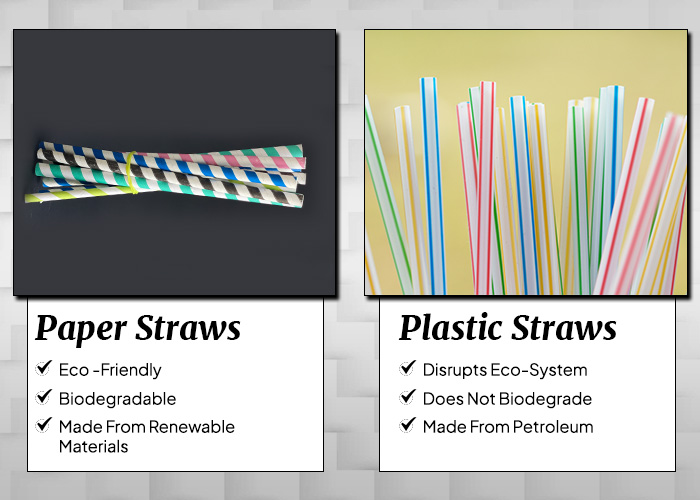The market for paper straws has expanded in response to the backlash against single-use plastics. Is the decision between them, though, really that easy?
There is no doubt about which one to go for when it comes to a choice between plastic and paper. Your environmentally conscious mind will always choose a paper straw over plastic. However, some individuals may be less concerned, not due to a lack of eco-consciousness but rather due to their busy schedules and preference for convenience over alternatives that may require additional effort to find.
Moving from plastic straws to eco-friendly paper straws might seem like a small change, but it’s not. Plastic straws can take up to 200 years to biodegrade, contributing to the astounding 12 billion tons of plastic waste projected to be in the ocean by 2050. As a result, the urgency of the hour is clearly evident.
The Problem with Plastic Straws
Plastic straws are among the most prevalent and well-known single-use plastics used just once before being discarded, making them one of the most unnecessary contributors to plastic pollution.
It is alarming that individuals in the United States consume half a billion plastic straws daily. Plastic straws are one of the most commonly consumed and discarded plastic products. As a result of the chemicals that are employed in their production, many different kinds of straws cannot be recycled or reused. In addition, the vast majority of plastic straws are not biodegradable and cannot be broken down naturally by bacteria and other decomposers.
Straws are among the most common and problematic items of litter, ending up in our waterways and eventually the oceans. This is due to a variety of sources, including beach pollution, wind that transports them from trash cans and collection facilities, and waterborne transportation such as barges, boats, and aquatic vehicles. Plastic straws frequently break apart in the environment, releasing toxic chemicals into the soil, air, and water. These compounds can be harmful to plants, animals, humans, and the environment in general.
The Rise of Paper Straws
From the beginning of the 2000s on, paper straws for drinks became popular, especially at soda stations and restaurants. But when plastic came out in the middle of the 20th century, paper straws quickly gave way to their plastic counterparts due to their perceived convenience and affordability. Paper straws have regained popularity in recent years as an environmentally friendly alternative to plastic straws. This is due to rising awareness of sustainability and tighter government prohibitions on plastic. The global paper straw market is expected to increase from $4.9 billion in 2023 to $11.5 billion in 2028, at a compound yearly growth rate (CAGR) of 18.9%. This expansion is mostly driven by the food and beverage industry, with demand rising as restaurants, hotels, and other food service establishments serve more people. The fall and rise of paper straws make us believe that switching is not that difficult. It’s only about the mindset, habits, and conscious choices you make.
Paper straws have regained popularity in recent years as an environmentally friendly alternative to plastic straws. This is due to rising awareness of sustainability and tighter government prohibitions on plastic. The global paper straw market is expected to increase from $4.9 billion in 2023 to $11.5 billion in 2028, at a compound yearly growth rate (CAGR) of 18.9%. This expansion is mostly driven by the food and beverage industry, with demand rising as restaurants, hotels, and other food service establishments serve more people. The fall and rise of paper straws make us believe that switching is not that difficult. It’s only about the mindset, habits, and conscious choices you make.
Making the Switch: Paper Straws vs. Plastic Straws
Disposable drinking straws are the frontrunners in the fight against single-use plastics, and with good reason. While some may dislike the feel or durability of paper straws, the environmental benefits are compelling.

Unlike their plastic counterparts, which can linger in the environment for about 300 years, paper straws decompose much faster. This quick biodegradation is essential, particularly in coastal environments. Plastic straws are routinely detected in beach clean-ups around the world, posing a significant threat to marine life. One heartbreaking video of a marine turtle with a plastic straw stuck in its nostril sparked a big anti-plastic straw movement.
Furthermore, paper straws are created from renewable resources, such as trees, which may be harvested and replaced sustainably. In contrast, plastic straws are made from non-renewable fossil resources. While others argue that paper straws have a higher carbon footprint owing to land use, this ignores the long-term environmental cost of plastic’s presence in ecosystems.
People are also becoming more aware of plastic waste, which is another reason for the switch to paper straws. Plastic straws are no longer used by companies like Starbucks and McDonald’s, and some states, like California, have banned them completely. This change isn’t just about straws; it’s part of a bigger awakening about how we use things. As Jackie Nuñez of The Last Plastic Straw notes, “The conversation about single-use plastic and the pollution it causes is now mainstream and global.”
On the one hand, it is fair to admit that paper straws are not quite perfect, but at the same time, they are a step forward that should be acknowledged. Their rise shows that when consumers demand change, industries listen, paving the way for a cleaner, greener future.
The Future of Sustainable Straws
Looking at the data, it is clear that the future of disposable paper straws is as bright as the sun, and people’s acceptance of them is like a ray towards sustainability. This trend is welcomed by brands and consumers alike, as they increasingly favour environmentally friendly alternatives. Anirudh Agro Industries stands out as a noteworthy example of this transformation. Known for their commitment to sustainability, they offer high-quality coloured and fancy paper straws that are perfect for organizations and individuals looking to make a positive environmental impact.














